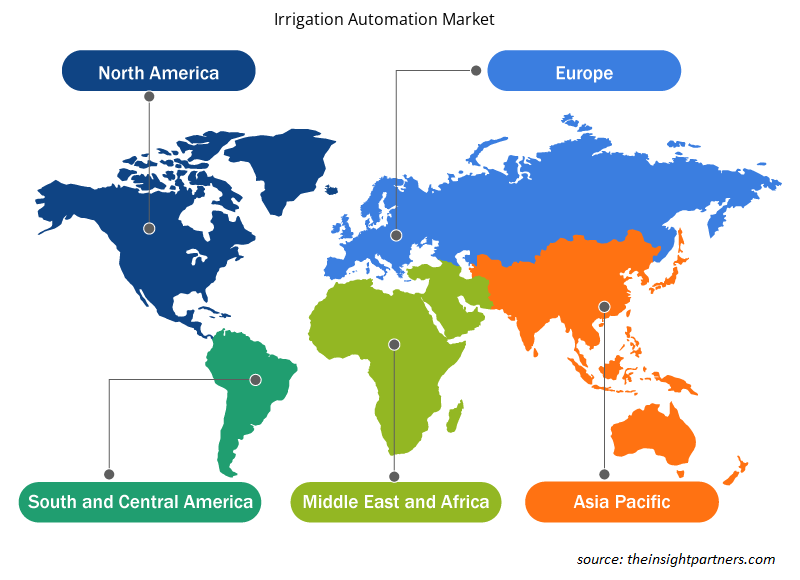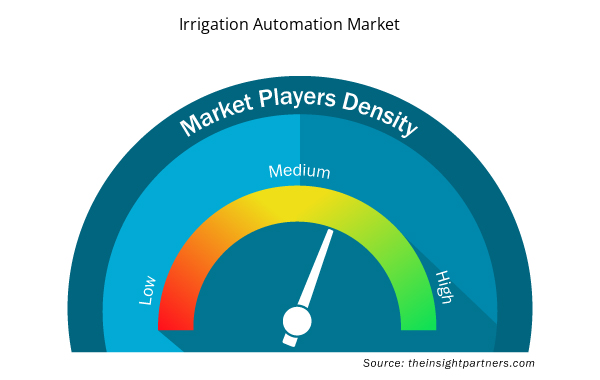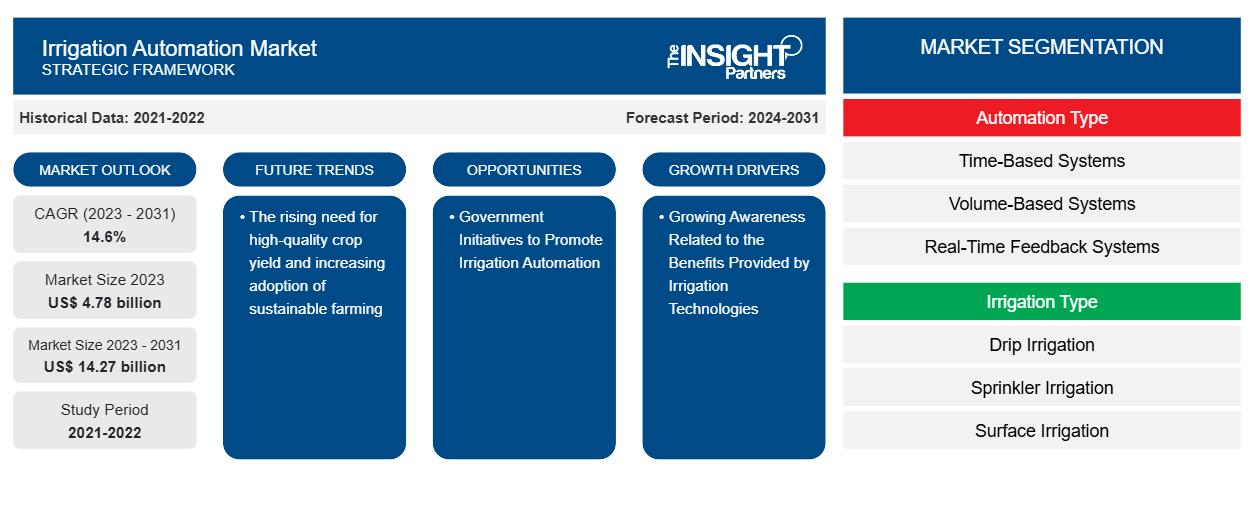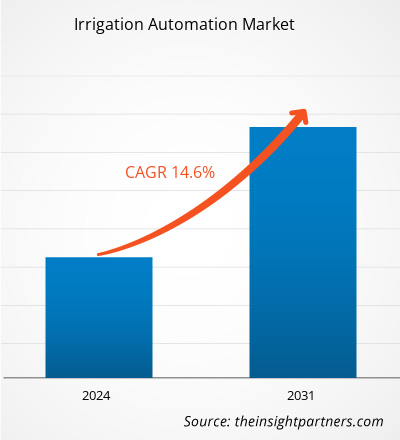Der Markt für Bewässerungsautomatisierung soll von 4,78 Milliarden US-Dollar im Jahr 2023 auf 14,27 Milliarden US-Dollar im Jahr 2031 anwachsen. Der Markt wird voraussichtlich zwischen 2023 und 2031 eine durchschnittliche jährliche Wachstumsrate von 14,6 % verzeichnen. Der steigende Bedarf an hochwertigen Ernteerträgen und die zunehmende Einführung nachhaltiger Landwirtschaft dürften weiterhin ein wichtiger Trend auf dem Markt für Bewässerungsautomatisierung bleiben.
Marktanalyse für Bewässerungsautomatisierung
Der Markt für Bewässerungsautomatisierung wächst rasant, da das Bewusstsein für die Vorteile von Bewässerungstechnologien wächst und präzise landwirtschaftliche Instrumente und Techniken akzeptiert werden. Der Markt wächst stetig, angetrieben von der steigenden Nachfrage nach intelligenten Agrartechnologien. Darüber hinaus bieten technologische Fortschritte und staatliche Initiativen zur Förderung der Bewässerungsautomatisierung lukrative Möglichkeiten für Marktwachstum.
Marktübersicht zur Bewässerungsautomatisierung
Bei der Bewässerungsautomatisierung werden Instrumente oder Geräte verwendet, um verschiedene Bewässerungssysteme zu betreiben und den Wasserfluss aus Buchten zu verändern. Die Bewässerungsautomatisierung umfasst die Kombination zahlreicher Hardware wie Sensoren, Ventile, Steuerungen, Sprinkler und mehr, um ein automatisiertes System aufzubauen, das sowohl für landwirtschaftliche als auch für nicht-landwirtschaftliche Anwendungen verwendet werden kann. Wesentliche Vorteile der Bewässerungsautomatisierung, wie Zeitersparnis, Kosteneffizienz, Ressourcenoptimierung und andere, treiben den Markt an.
Passen Sie diesen Bericht Ihren Anforderungen an
Sie erhalten kostenlose Anpassungen an jedem Bericht, einschließlich Teilen dieses Berichts oder einer Analyse auf Länderebene, eines Excel-Datenpakets sowie tolle Angebote und Rabatte für Start-ups und Universitäten.
- Holen Sie sich die wichtigsten Markttrends aus diesem Bericht.Dieses KOSTENLOSE Beispiel umfasst eine Datenanalyse von Markttrends bis hin zu Schätzungen und Prognosen.
Markttreiber und Chancen für die Bewässerungsautomatisierung
Wachsendes Bewusstsein für die Vorteile von Bewässerungstechnologien treibt den Markt an
Landwirte werden sich der automatisierten Bewässerungstechnologien, die mit hohen Arbeits- und Stromkosten verbunden sind, immer bewusster. Bewässerungstechnologien bieten den Anwendern erhebliche Vorteile, wie Wassereinsparung, Prozessautomatisierung und Kosteneinsparungen, die den Markt antreiben. Diese Vorteile erhöhen das Bewusstsein der Landwirte, was die Einführung von Bewässerungstechnologien vorantreibt. Diese Technologien unterstützen Landwirte dabei, ihren täglichen Stromverbrauch zu senken und den Zeit- und Arbeitsaufwand für die Bewässerung zu reduzieren. Darüber hinaus konnten Landwirte durch die Automatisierung die Anzahl der Fahrten zum Hof reduzieren, was zu geringeren Arbeitskosten führte. Die Installation eines automatisierten Bewässerungssystems verbessert die landwirtschaftliche Präzision, indem die genaue Wassermenge und die Bewässerungszeit bestimmt werden. Diese Präzision reduziert Ernteverluste für Landwirte und steigert die Gesamtproduktivität.
Regierungsinitiativen zur Förderung der Bewässerungsautomatisierung – eine Chance auf dem Markt für Bewässerungsautomatisierung
Die Mehrheit der Landwirte in unterentwickelten Ländern verwendet konventionelle Bewässerungssysteme (Oberflächenbewässerung), was ein zeitaufwändiger Prozess ist. Dies ermutigt die Regierungen verschiedener Länder, positive Initiativen zur Förderung der Bewässerungsautomatisierung zu ergreifen, was voraussichtlich Chancen auf dem Markt schaffen wird. Viele Regierungen in Entwicklungsländern wie Indien, China, Brasilien, den USA, Frankreich und anderen afrikanischen Ländern bieten Zuschüsse für den Kauf von Tropf- und Sprinklersystemen an, um die Effizienz ihrer Bewässerungssysteme zu steigern. Darüber hinaus helfen strenge Richtlinien, die den Einsatz von Sprinkler- und Tropfbewässerungssystemen fördern, den Landwirten, technologisch entwickelte Systeme auf ihren Farmen einzuführen, wie z. B. den Erwerb und die Neuinstallation von landwirtschaftlichen Bewässerungsgeräten ( Sprinkler- und Tropfbewässerungssysteme). Diese Faktoren schaffen im Prognosezeitraum erhebliche Wachstumschancen für den Markt.
Segmentierungsanalyse des Marktberichts zur Bewässerungsautomatisierung
Wichtige Segmente, die zur Ableitung der Marktanalyse zur Bewässerungsautomatisierung beigetragen haben, sind Automatisierungstyp, Bewässerungstyp, Komponente, System und Endbenutzer.
- Basierend auf der Art der Automatisierung ist der Markt in zeitbasierte Systeme, volumenbasierte Systeme, Echtzeit-Feedbacksysteme und computergestützte Bewässerungssteuerungssysteme unterteilt. Das Segment der zeitbasierten Systeme hatte im Jahr 2023 einen größeren Marktanteil.
- Auf der Grundlage der Bewässerungsart ist der Markt in Tropfbewässerung, Sprinklerbewässerung und Oberflächenbewässerung unterteilt. Das Segment der Tropfbewässerung hatte im Jahr 2023 einen größeren Marktanteil.
- In Bezug auf die Komponenten ist der Markt in Steuerungen, Sensoren, Ventile, Sprinkler und andere unterteilt. Das Segment der Steuerungen hatte im Jahr 2023 einen größeren Marktanteil.
- Basierend auf dem System ist der Markt für Bewässerungsautomatisierung in automatisch und halbautomatisch unterteilt. Das automatische Segment hatte im Jahr 2023 einen größeren Marktanteil.
- In Bezug auf die Endverwendung wird der Markt in landwirtschaftlich und nicht-landwirtschaftlich unterteilt. Das Agrarsegment hatte im Jahr 2023 einen größeren Marktanteil.
Marktanteilsanalyse für Bewässerungsautomatisierung nach Geografie
Der geografische Umfang des Marktberichts zur Bewässerungsautomatisierung ist hauptsächlich in fünf Regionen unterteilt: Nordamerika, Asien-Pazifik, Europa, Naher Osten und Afrika sowie Südamerika/Süd- und Mittelamerika.
In Bezug auf den Umsatz hatte der asiatisch-pazifische Raum aufgrund der großen landwirtschaftlichen Flächen und der günstigen staatlichen Unterstützung den größten Marktanteil im Bereich der Bewässerungsautomatisierung. Es wird erwartet, dass der Markt in naher Zukunft expandieren wird, was auf die raschen Veränderungen der Klimabedingungen und die wachsende Notwendigkeit zur Reduzierung der Abfallverschwendung zurückzuführen ist. Darüber hinaus kurbeln technologische Fortschritte und die Entwicklung fortschrittlicher Bewässerungssysteme den Markt im Prognosezeitraum an.
Regionale Einblicke in den Markt für Bewässerungsautomatisierung
Die regionalen Trends und Faktoren, die den Markt für Bewässerungsautomatisierung im Prognosezeitraum beeinflussen, wurden von den Analysten von Insight Partners ausführlich erläutert. In diesem Abschnitt werden auch die Marktsegmente und die Geografie der Bewässerungsautomatisierung in Nordamerika, Europa, im asiatisch-pazifischen Raum, im Nahen Osten und Afrika sowie in Süd- und Mittelamerika erörtert.

- Erhalten Sie regionale Daten zum Markt für Bewässerungsautomatisierung
Umfang des Marktberichts zur Bewässerungsautomatisierung
| Berichtsattribut | Details |
|---|---|
| Marktgröße im Jahr 2023 | 4,78 Milliarden US-Dollar |
| Marktgröße bis 2031 | 14,27 Milliarden US-Dollar |
| Globale CAGR (2023 - 2031) | 14,6 % |
| Historische Daten | 2021-2022 |
| Prognosezeitraum | 2024–2031 |
| Abgedeckte Segmente | Nach Automatisierungstyp
|
| Abgedeckte Regionen und Länder | Nordamerika
|
| Marktführer und wichtige Unternehmensprofile |
|
Marktteilnehmerdichte: Der Einfluss auf die Geschäftsdynamik
Der Markt für Bewässerungsautomatisierung wächst rasant, angetrieben durch die steigende Nachfrage der Endnutzer aufgrund von Faktoren wie sich entwickelnden Verbraucherpräferenzen, technologischen Fortschritten und einem größeren Bewusstsein für die Vorteile des Produkts. Mit steigender Nachfrage erweitern Unternehmen ihr Angebot, entwickeln Innovationen, um die Bedürfnisse der Verbraucher zu erfüllen, und nutzen neue Trends, was das Marktwachstum weiter ankurbelt.
Die Marktteilnehmerdichte bezieht sich auf die Verteilung der Firmen oder Unternehmen, die in einem bestimmten Markt oder einer bestimmten Branche tätig sind. Sie gibt an, wie viele Wettbewerber (Marktteilnehmer) in einem bestimmten Marktraum im Verhältnis zu seiner Größe oder seinem gesamten Marktwert präsent sind.
Die wichtigsten auf dem Markt für Bewässerungsautomatisierung tätigen Unternehmen sind:
- Galcon GmbH
- Hunter Industries Inc.
- Irritec SpA
- Jain Irrigation Systems Ltd.
- Lindsay Corporation
- Nelson Irrigation Corporation
Haftungsausschluss : Die oben aufgeführten Unternehmen sind nicht in einer bestimmten Reihenfolge aufgeführt.

- Überblick über die wichtigsten Akteure auf dem Markt für Bewässerungsautomatisierung
Neuigkeiten und aktuelle Entwicklungen zum Markt für Bewässerungsautomatisierung
Der Markt für Bewässerungsautomatisierung wird durch die Erhebung qualitativer und quantitativer Daten nach Primär- und Sekundärforschung bewertet, die wichtige Unternehmensveröffentlichungen, Verbandsdaten und Datenbanken umfasst. Im Folgenden finden Sie eine Liste der Entwicklungen auf dem Markt für Bewässerungsautomatisierung und -strategien:
- Im März 2024 teilt Rubicon Water sein neuestes Projekt an der Grenze zwischen Usbekistan und Tadschikistan. Dieses innovative Projekt, das vom Schweizer Kooperationsbüro und der Blue Peace Initiative unterstützt wird, konzentriert sich auf die grenzüberschreitende Verteilung und Messung, um die Zusammenarbeit im grenzüberschreitenden Wassermanagement zu fördern. Neben der Verbesserung des Wassermanagements für die Bewässerung spielt die Technologie von Rubicon eine zunehmend entscheidende Rolle im Grundwassermanagement, bei Aufladeprogrammen und Umweltflussinitiativen und trägt zur Erhaltung lebenswichtiger Wasserressourcen und Ökosysteme bei. (Quelle: Rubicon Water, Pressemitteilung, 2024)
Marktbericht zur Bewässerungsautomatisierung – Umfang und Ergebnisse
Der Bericht „Marktgröße und Prognose für Bewässerungsautomatisierung (2021–2031)“ bietet eine detaillierte Analyse des Marktes, die die folgenden Bereiche abdeckt:
- Marktgröße und Prognose auf globaler, regionaler und Länderebene für alle wichtigen Marktsegmente, die im Rahmen des Projekts abgedeckt sind
- Marktdynamik wie Treiber, Beschränkungen und wichtige Chancen
- Wichtige Zukunftstrends
- Detaillierte PEST/Porters Five Forces- und SWOT-Analyse
- Globale und regionale Marktanalyse mit wichtigen Markttrends, wichtigen Akteuren, Vorschriften und aktuellen Marktentwicklungen
- Branchenlandschaft und Wettbewerbsanalyse, einschließlich Marktkonzentration, Heatmap-Analyse, prominenten Akteuren und aktuellen Entwicklungen
- Detaillierte Firmenprofile
- Historische Analyse (2 Jahre), Basisjahr, Prognose (7 Jahre) mit CAGR
- PEST- und SWOT-Analyse
- Marktgröße Wert/Volumen – Global, Regional, Land
- Branche und Wettbewerbsumfeld
- Excel-Datensatz



Report Coverage
Revenue forecast, Company Analysis, Industry landscape, Growth factors, and Trends

Segment Covered
This text is related
to segments covered.

Regional Scope
North America, Europe, Asia Pacific, Middle East & Africa, South & Central America

Country Scope
This text is related
to country scope.
Häufig gestellte Fragen
The global irrigation automation market was estimated to be US$ 4.78 billion in 2023 and is expected to grow at a CAGR of 14.6% during the forecast period 2023 - 2031.
The growing awareness related to the benefits provided by irrigation technologies and the acceptance of precise agriculture instruments and techniques are the major factors that propel the global irrigation automation market.
The rising need for high-quality crop yield and increasing adoption of sustainable farming to play a significant role in the global irrigation automation market in the coming years.
The key players holding majority shares in the global irrigation automation market are Galcon Ltd., Hunter Industries Inc., Irritec S.p.A, Jain Irrigation Systems Ltd., and Lindsay Corporation.
The global irrigation automation market is expected to reach US$ 14.27 billion by 2031.
The incremental growth expected to be recorded for the global irrigation automation market during the forecast period is US$ 9.48 billion.
Trends and growth analysis reports related to Electronics and Semiconductor : READ MORE..
The Insight Partners performs research in 4 major stages: Data Collection & Secondary Research, Primary Research, Data Analysis and Data Triangulation & Final Review.
- Data Collection and Secondary Research:
As a market research and consulting firm operating from a decade, we have published and advised several client across the globe. First step for any study will start with an assessment of currently available data and insights from existing reports. Further, historical and current market information is collected from Investor Presentations, Annual Reports, SEC Filings, etc., and other information related to company’s performance and market positioning are gathered from Paid Databases (Factiva, Hoovers, and Reuters) and various other publications available in public domain.
Several associations trade associates, technical forums, institutes, societies and organization are accessed to gain technical as well as market related insights through their publications such as research papers, blogs and press releases related to the studies are referred to get cues about the market. Further, white papers, journals, magazines, and other news articles published in last 3 years are scrutinized and analyzed to understand the current market trends.
- Primary Research:
The primarily interview analysis comprise of data obtained from industry participants interview and answers to survey questions gathered by in-house primary team.
For primary research, interviews are conducted with industry experts/CEOs/Marketing Managers/VPs/Subject Matter Experts from both demand and supply side to get a 360-degree view of the market. The primary team conducts several interviews based on the complexity of the markets to understand the various market trends and dynamics which makes research more credible and precise.
A typical research interview fulfils the following functions:
- Provides first-hand information on the market size, market trends, growth trends, competitive landscape, and outlook
- Validates and strengthens in-house secondary research findings
- Develops the analysis team’s expertise and market understanding
Primary research involves email interactions and telephone interviews for each market, category, segment, and sub-segment across geographies. The participants who typically take part in such a process include, but are not limited to:
- Industry participants: VPs, business development managers, market intelligence managers and national sales managers
- Outside experts: Valuation experts, research analysts and key opinion leaders specializing in the electronics and semiconductor industry.
Below is the breakup of our primary respondents by company, designation, and region:

Once we receive the confirmation from primary research sources or primary respondents, we finalize the base year market estimation and forecast the data as per the macroeconomic and microeconomic factors assessed during data collection.
- Data Analysis:
Once data is validated through both secondary as well as primary respondents, we finalize the market estimations by hypothesis formulation and factor analysis at regional and country level.
- Macro-Economic Factor Analysis:
We analyse macroeconomic indicators such the gross domestic product (GDP), increase in the demand for goods and services across industries, technological advancement, regional economic growth, governmental policies, the influence of COVID-19, PEST analysis, and other aspects. This analysis aids in setting benchmarks for various nations/regions and approximating market splits. Additionally, the general trend of the aforementioned components aid in determining the market's development possibilities.
- Country Level Data:
Various factors that are especially aligned to the country are taken into account to determine the market size for a certain area and country, including the presence of vendors, such as headquarters and offices, the country's GDP, demand patterns, and industry growth. To comprehend the market dynamics for the nation, a number of growth variables, inhibitors, application areas, and current market trends are researched. The aforementioned elements aid in determining the country's overall market's growth potential.
- Company Profile:
The “Table of Contents” is formulated by listing and analyzing more than 25 - 30 companies operating in the market ecosystem across geographies. However, we profile only 10 companies as a standard practice in our syndicate reports. These 10 companies comprise leading, emerging, and regional players. Nonetheless, our analysis is not restricted to the 10 listed companies, we also analyze other companies present in the market to develop a holistic view and understand the prevailing trends. The “Company Profiles” section in the report covers key facts, business description, products & services, financial information, SWOT analysis, and key developments. The financial information presented is extracted from the annual reports and official documents of the publicly listed companies. Upon collecting the information for the sections of respective companies, we verify them via various primary sources and then compile the data in respective company profiles. The company level information helps us in deriving the base number as well as in forecasting the market size.
- Developing Base Number:
Aggregation of sales statistics (2020-2022) and macro-economic factor, and other secondary and primary research insights are utilized to arrive at base number and related market shares for 2022. The data gaps are identified in this step and relevant market data is analyzed, collected from paid primary interviews or databases. On finalizing the base year market size, forecasts are developed on the basis of macro-economic, industry and market growth factors and company level analysis.
- Data Triangulation and Final Review:
The market findings and base year market size calculations are validated from supply as well as demand side. Demand side validations are based on macro-economic factor analysis and benchmarks for respective regions and countries. In case of supply side validations, revenues of major companies are estimated (in case not available) based on industry benchmark, approximate number of employees, product portfolio, and primary interviews revenues are gathered. Further revenue from target product/service segment is assessed to avoid overshooting of market statistics. In case of heavy deviations between supply and demand side values, all thes steps are repeated to achieve synchronization.
We follow an iterative model, wherein we share our research findings with Subject Matter Experts (SME’s) and Key Opinion Leaders (KOLs) until consensus view of the market is not formulated – this model negates any drastic deviation in the opinions of experts. Only validated and universally acceptable research findings are quoted in our reports.
We have important check points that we use to validate our research findings – which we call – data triangulation, where we validate the information, we generate from secondary sources with primary interviews and then we re-validate with our internal data bases and Subject matter experts. This comprehensive model enables us to deliver high quality, reliable data in shortest possible time.


 Holen Sie sich ein kostenloses Muster für diesen Bericht
Holen Sie sich ein kostenloses Muster für diesen Bericht